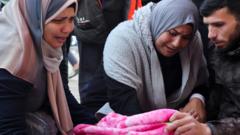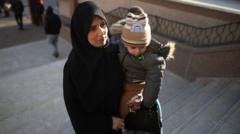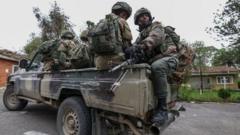Research published in *The Lancet* highlights the potential for a much higher death toll in the ongoing war, raising critical questions about the reliability of current figures.
**New Study Suggests Gaza War Casualties May Be Much Higher Than Official Reports**

**New Study Suggests Gaza War Casualties May Be Much Higher Than Official Reports**
A recent analysis raises concerns that the number of casualties in the Gaza conflict could be significantly underreported.
The death toll from the war in Gaza could be drastically higher than what officials are currently reporting, according to new findings from a UK-led research team. The study, appearing in *The Lancet* medical journal, analyzed the first nine months of conflict that began with a Hamas attack on Israel on October 7, 2023. Using data gathered from the Hamas-run Palestinian Ministry of Health, online surveys collecting testimonials from relatives of victims, and local obituaries, the researchers estimated that as of June 30, 2024, the death toll from traumatic injuries was around 64,260 – an alarming increase of 41% compared to governmental figures.
The Israeli embassy in the UK promptly dismissed the study's findings, stating that any information emerging from Gaza is unreliable and serves Hamas. In contrast, the United Nations treats the health ministry's numbers as credible, although they do not differentiate between combatants and non-combatants. A recent UN report highlighted that in a six-month window, the majority of confirmed casualties were women and children.
Israel has publicly questioned the accuracy of the health ministry's statistics. The Israel Defense Forces (IDF) has claimed responsibility for eliminating over 17,000 Hamas operatives, though the methodologies behind this figure remain unclear. The IDF maintains that their primary targets are combatants and that they endeavor to minimize civilian casualties during military operations. Yet, the ongoing conflict poses challenges for independent verification due to restrictions on international journalists' access to Gaza, complicating fact-checking efforts.
Utilizing a statistical approach known as "capture-recapture," the researchers from the London School of Hygiene & Tropical Medicine aimed to triangulate fatalities reported across different sources to unveil a more accurate tally. The overlap between these lists hinted at a significantly augmented death toll tied to traumatic injuries not reflected in official health ministry records.
The research estimates the death toll in Gaza ranging from 55,298 to 78,525, as opposed to the 37,877 reported by the health ministry. It's worth noting that the numbers could fluctuate based on the methodological rigor of the analysis. Discrepancies in identifying deaths from "traumatic injury" could lead to adjustments in either direction.
Moreover, the study emphasized that a staggering 59% of those deceased for whom demographic information was accessible were identified as women, children, and the elderly. The escalation of violence in Gaza has roots in the initial Hamas assault which resulted in 1,200 casualties and the abduction of 251 hostages. In retaliation, Israel initiated extensive military actions against Gaza, with the health ministry reporting that 46,006 individuals, predominantly civilians, have died due to Israeli military operations since the start of the conflict.
As discussions about the accuracy of casualty figures continue, many are left wondering what the humanitarian implications might be for the civilians caught in this ongoing conflict as the war’s toll remains a contentious topic both locally and internationally.
The Israeli embassy in the UK promptly dismissed the study's findings, stating that any information emerging from Gaza is unreliable and serves Hamas. In contrast, the United Nations treats the health ministry's numbers as credible, although they do not differentiate between combatants and non-combatants. A recent UN report highlighted that in a six-month window, the majority of confirmed casualties were women and children.
Israel has publicly questioned the accuracy of the health ministry's statistics. The Israel Defense Forces (IDF) has claimed responsibility for eliminating over 17,000 Hamas operatives, though the methodologies behind this figure remain unclear. The IDF maintains that their primary targets are combatants and that they endeavor to minimize civilian casualties during military operations. Yet, the ongoing conflict poses challenges for independent verification due to restrictions on international journalists' access to Gaza, complicating fact-checking efforts.
Utilizing a statistical approach known as "capture-recapture," the researchers from the London School of Hygiene & Tropical Medicine aimed to triangulate fatalities reported across different sources to unveil a more accurate tally. The overlap between these lists hinted at a significantly augmented death toll tied to traumatic injuries not reflected in official health ministry records.
The research estimates the death toll in Gaza ranging from 55,298 to 78,525, as opposed to the 37,877 reported by the health ministry. It's worth noting that the numbers could fluctuate based on the methodological rigor of the analysis. Discrepancies in identifying deaths from "traumatic injury" could lead to adjustments in either direction.
Moreover, the study emphasized that a staggering 59% of those deceased for whom demographic information was accessible were identified as women, children, and the elderly. The escalation of violence in Gaza has roots in the initial Hamas assault which resulted in 1,200 casualties and the abduction of 251 hostages. In retaliation, Israel initiated extensive military actions against Gaza, with the health ministry reporting that 46,006 individuals, predominantly civilians, have died due to Israeli military operations since the start of the conflict.
As discussions about the accuracy of casualty figures continue, many are left wondering what the humanitarian implications might be for the civilians caught in this ongoing conflict as the war’s toll remains a contentious topic both locally and internationally.






















